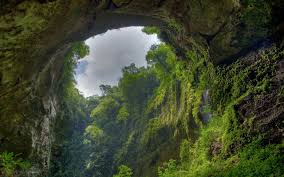
Feb 22, 2018
At first glance, a cave doesn’t seem the likeliest home for exotically lush flora. It’s dark, damp and dingy, more likely to host sparkly stalagmites than bristly bushes.
It turns out, though, that China’s caverns play host to a stunning variety of plants, including some found nowhere else in the world. That’s according to a new paper published in PLOS ONE.
Over five years, researchers visited more than 60 caves in the southern Guangxi, Guizhou and Yunnan regions of China. They targeted some of the country’s least-explored areas. Their goal was to catalogue every plant species they found in more detail than ever before. (As one researcher described an early visit, “That first visit transported me to another world, an eerie moonscape in which plants thrived in powdery ‘soil’ and perpetual twilight.”)
By the end of their work, they had uncovered 418 types of flora and fauna in the caves, including 31 plants that exist nowhere else. Thirty-seven percent of the species they found do not exist outside China. “Before we started we had no idea of the diversity of plants in caves, or that so many species are known only from caves,” Alexander Monro, a biologist from the Kew Royal Botanic Gardens who led the study, wrote in a statement.
The researchers say most of the endemic plants were found near the entryways of the caves, what the researchers called “twilight zones.” That piece of evidence has generated an unusual theory: that many of the plants once lived outside the caves, too, but were wiped out by deforestation.
The researchers believe that they were once part of a continuum of vegetation that extended into the understory of the surrounding forest, or the layer of vegetation in the shaded area between the canopy and the ground.
Large swaths of Chinese forests were erased during the 1950s through 1970s as part of the country’s rapid industrialization and Mao Zedong’s Great Leap Forward. That has been linked to some of China’s biggest environmental challenges, including poor air quality and severe erosion.
More recently, the country has been working to address this issue. Between 2000 and 2010, China’s forest cover grew by 46,000 square miles, thanks in large part to a significant crackdown on illegal mining. (Unfortunately, China’s commitment to preserve and grow its own forests has resulted in massive deforestation elsewhere.)










